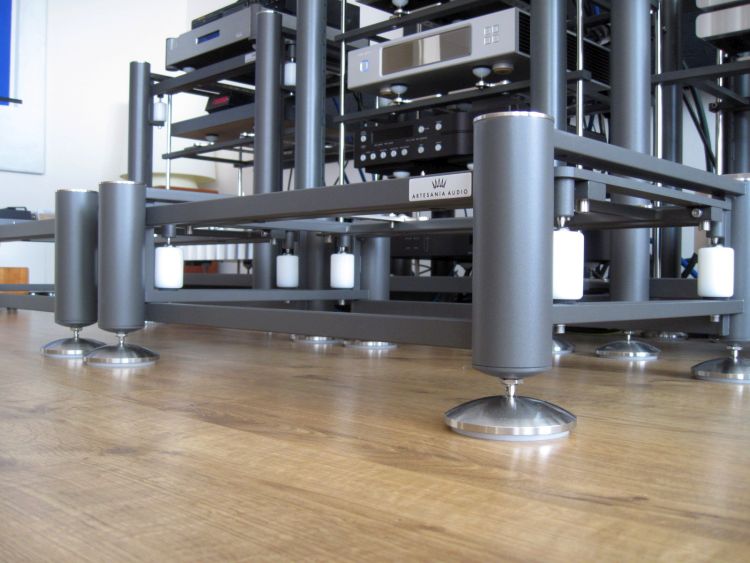
These sophisticated platforms do not merely add the last nth of quality, they actually transform the sound, in a musically meaningful manner.
Review samples provided by Artesania Audio
Retail price: 3395 euro in the BeNeLux
After having been amazed at the audiophile qualities of the Artesania Exoteryc audio racks there was no doubt in my mind that the Aire Floor Platforms would perform admirably in the context of my system. But I was not prepared for the incredible musical transformation that they achieved in my friend JW’s previously non-Artesania’d setup.
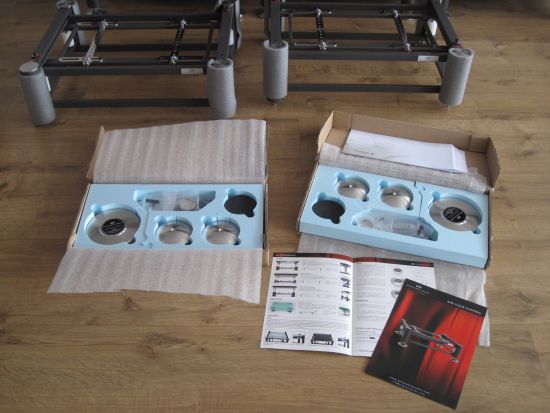
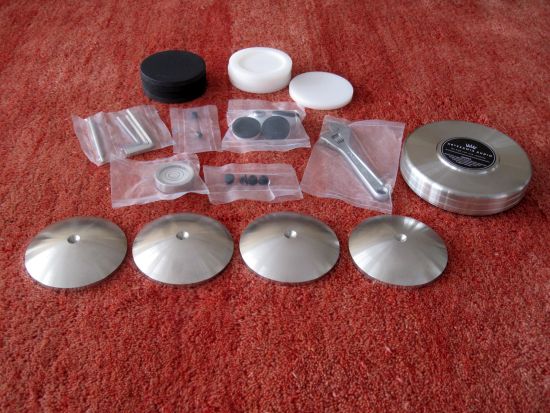
Above: all Artesania products come with various accessories, including two types of floor pads (nylon and neoprene) to tune the sound to your liking. I used the white nylon ones which provide a livelier sound than the neoprene ones.
Because there are already three Exoteryc racks in my own system, I opted to assess the Aire Floor Platforms in JW’s system. JW and I have quite similar setups, which makes it easy to draw parallels. While our speakers differ (he has Apogee Duetta Signature speakers and I have Apogee Divas), JW has the same Jeff Rowland model 6 power amps, the same Transparent and Cardas cables, and the same brand preamp and source. Before I got my Artesania racks, for the longest time I used Finite Elemente Spider racks. JW still uses a Spider rack for all his equipment except for the power amps which are on spikes and directly on the floor. Because I know his system so well, I thought I could at least partially forecast the expected influence of the Aire platforms on the sound.
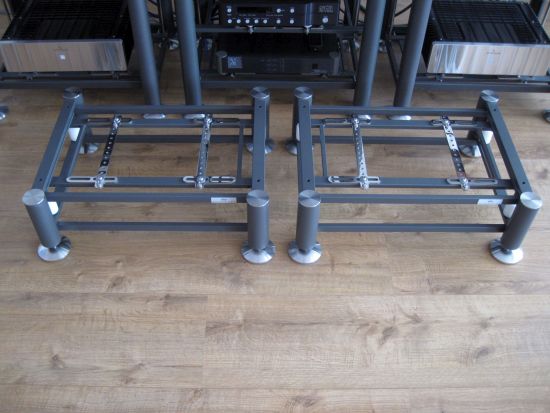
Imagine our surprise when the difference turned out to be much larger than anticipated. I was expecting a smoother, more relaxed sound and this was indeed the case, but this is only part of the story. The increased smoothness does not come at the expense of reduced liveliness or a lack of attack, rather, it was now evident that all this time the spikes had been injecting a false sense of transient sharpness. Much like a sharpness control with a TV where adding sharpness adds false edges, the same seems to happen in audio when spikes are used.
What I already knew from my own Artesania racks is that they enable a tonally richer sound but definitely do not add any coloration like so many shelved and/or wooden racks do. And indeed, comparing the model 6’s sound on spikes versus them placed on the Aire platforms, their basic tonality is not changed at all, and that is a very good thing. Although the bass is much fuller on Artesania racks than on Spider racks, the sound does not become dark: every bit of treble air is retained. The racks do not add romanticism and definitely do not add any cream or sauce and so do not serve as a sweetener for bad recordings, but they also do not slay those lesser recordings. They do allow the music to flow way more freely, enabling a deeper emotional connection.
What was most fascinating was the wholly natural musical backdrop from which the various instruments arose in their own positions both horizontally and laterally, freed from restraint. The impression is of a wholly organic sound where the whole is left intact, so no individual aspects are highlighted at the expense of others. In this respect, the Artesania “sound” is similar to the way that Cardas cables treat music: as a coherent, lifelike presentation, rather than one dissected into separate elements. Instruments such as guitars sound richer, not because the sound has thickened, but because the upper harmonics are more clearly audible, instead of being tied together as would happen with hard-coupling using spikes (due to resonance buildup?).
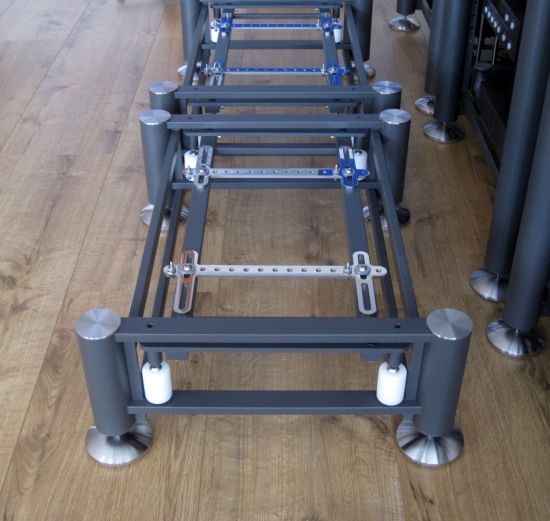
Blackness versus decay
It’s often said that deep blacks in recordings are good, the silence between the notes identifying the lack of residual noise. While this may be true in some circumstances, I find that black holes in music can also be caused by too much damping which basically kills the decay of longer notes, somewhat like a compact cassette recording without Dolby, played back with Dolby. How shall I put this… with the Artesania Aire platforms it sounds like the dynamic range has been extended downward, allowing more differentiation in low-level details. You really can hear the tiniest details yet there is no black hole effect, rather, there is this analog-like continuousness to the music that is highly infectious.
Dynamics
What’s more, while on the surface music might now sound less urgent due to the lack of transient overshoot and the peaky ultra articulation in the bass so typical of the spike sound, the sensation of real dynamics is actually greatly enhanced. Much as is the case with Jeff Rowland equipment, the dynamic range is extended downward, meaning that while the music is less “in your face”, individual sounds now actually emerge with more power and decay longer and more freely than before. Perhaps compared to spikes or placement in a Spider rack the bass with the Aire Platforms could be a smidgeon tighter, but if that would mean that the midrange would lose some of its free-flowing magic or treble would become edgier, then in my view the tradeoff would not be worth it and I know what I would choose. In any event, this is an aspect that can be compensated for elsewhere in the system, if so desired. An added bonus is that due to the absence of grain and edge it is possible to play louder without any strain.
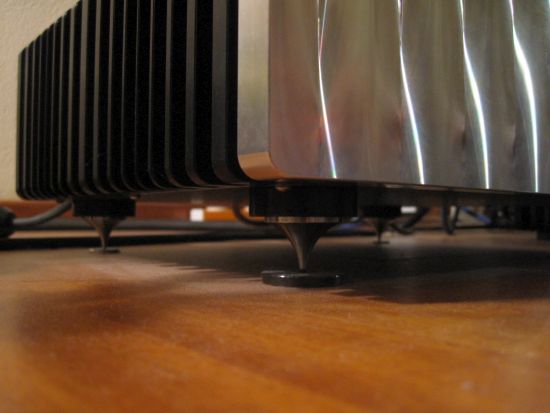
Above: Jeff Rowland model 6 power amp with its standard spikes, hard-coupled to the floor.
Soundstage
Truly unexpected was the huge improvement in soundstage size and image layering. The stage grew in all dimensions to become wider, higher, and deeper, and the whole presentation lifted. The sound also expanded more in front of the speakers, but only as the music required, with vocals or individual instruments stepping forward from the mix, not in an always-forward manner. The longer we listened, the more impressed we were. This was not so much because the platforms were slowly revealing their qualities but likely mostly because the amps and racks needed to settle after being set up. The laminate wood floor is laid on top of two soft insulating material layers and the Aire Platform’s feet were in positions where the floor had not been pressured before, so I think the material needed to depress and settle before ideal coupling was achieved.
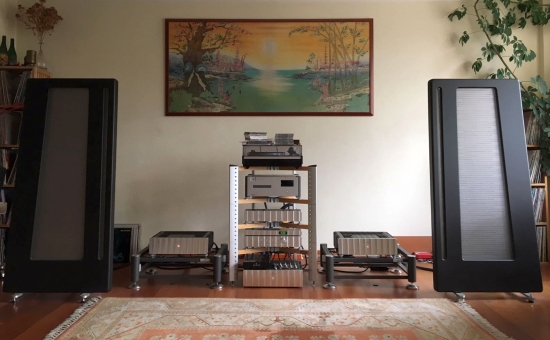
Above: JW’s setup: Apogee Duetta Signature, Jeff Rowland Synergy IIi, Wadia 861, and Jeff Rowland Model 6 power amps.
The absence of spikes
Spikes initially provide a welcome increase in transient sharpness and while this may have been needed in JW’s past setup, incremental improvements accumulated over the years have moved the system to such a position that clearly it was ready for the next step. The model sixes apparently still have margin in their performance which only comes out when the circumstances are right. For example, we now heard clearly that they are capable of even more subtlety and even more natural timbre. It is on the Aire platforms that JW’s leaner-sounding Apogee Duettas start to sound like Divas, with a so-far unheard naturalness and tonal rightness. Not only do woodworks and synths sound more detailed and simultaneously more enveloping, but vocals and percussive instruments also sound more believable and real. Compared with the Aire sound, the spikes made the instruments sound clinched and the whole presentation much smaller. Incidentally, the Aire platforms appear to have spiked feet, but instead of being very pointy, their tips end in a small round ball-shaped section.
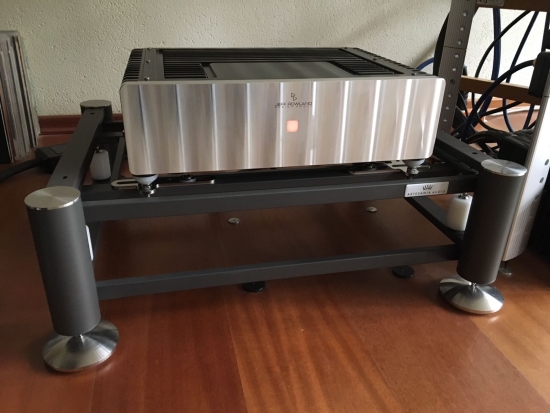
I’ve said it many times before and I will say it again: audio is all about balance. A great component in one system does not guarantee great performance in another system. Spikes may well be the answer in a system that lacks spirit or articulation but in JW’s system (with very open and detailed Apogee speakers) it was clear that they no longer served the good cause. The Artesania racks make it possible for the equipment to really shine, revealing all the subtlety and naturalness that they are capable of, without adding any influence of their own, be it hardness or a particular tonality. The Artesania racks simply allow for incredibly neutral, natural, and lifelike sound without making your components sound boring or overly clean.
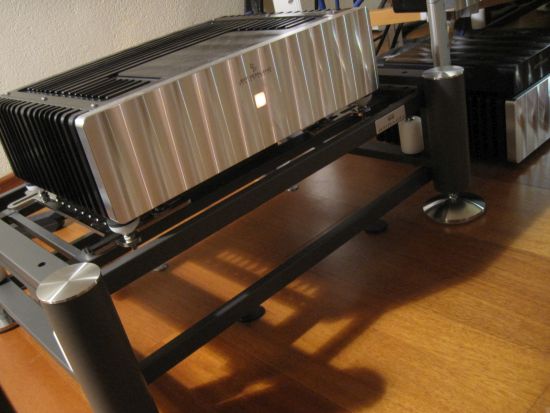
While a comparison with the Exoteryc rack seems obvious as the two share the same materials, dimensions, and build, the Aire does sound different from the lowest level of an Exoteryc rack. Actually, it sounds a lot like the uppermost level of an Exoteryc rack. That makes sense, because these racks are actually a rack within a rack, with the inner rack “hinging” in a pendulum-like manner on 4 nylon cylinders which means that the lowest level has the most swing, which results in an audible difference from level to level. The topmost level sounds most articulate and the bottom-most level sounds most fluid. Which level is best depends on the component used and the compensation that is required, but in general, I tend to find the uppermost 2 levels to sound best and this is good news for the Aire platform because it is, in essence, a very low top level.
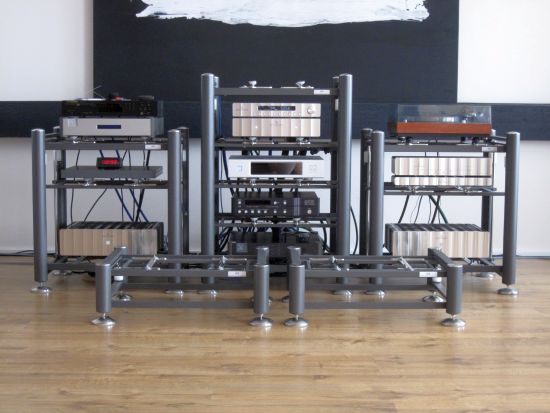
Conclusion
Because of their carefully balanced mix of coupling and decoupling, the Aire Platforms have no sound of their own, yet they allow for a smoother, more organic sound than any other rack that I have used so far. In this aspect, I think they are unique. If anything I’d say that they allow components to sound as tonally full as they really are, allowing upper harmonics to bloom, as opposed to making them sound thinner and subjectively faster while cutting off the decays as happens with so many other racks.
Artesania racks and platforms do not magically make a cheap component sound like a million bucks. On the other hand, they also do not have any subtractive effects so you could say that in a sense they are forgiving, especially when compared to glass or racks with spiked levels. When the quality is inherently present in the components used, these platforms will allow it to be extended fully.
Granted, these platforms are not cheap. But given their incredible effect, I feel they are worth the expense. Especially if you have a system that has the inherent quality, and you are not looking to replace any components, then the addition of one or two Artesania Aire Floor Platform(s) for your amplifier(s) is just the ticket. And trust me on this: they do not merely add the last nth of quality, they actually transform the sound, in a musically meaningful manner.

Technical Details:
Width: 67cm
Depth: 52,5cm
Height: 23,5cm
Supported Weight: 200kg
Colors: reviewed in Anthracite, upon request also available in silver and black
Read Also
Artesania Aire Floor Platform – update August 2022
External Links
Manufacturer: Artesania Audio
Distributor for the Benelux: Aspera Audio
Krion website: Krion.com/en


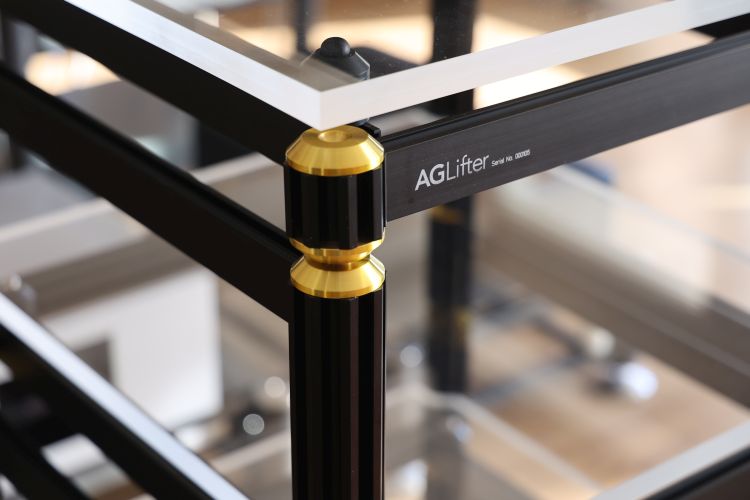
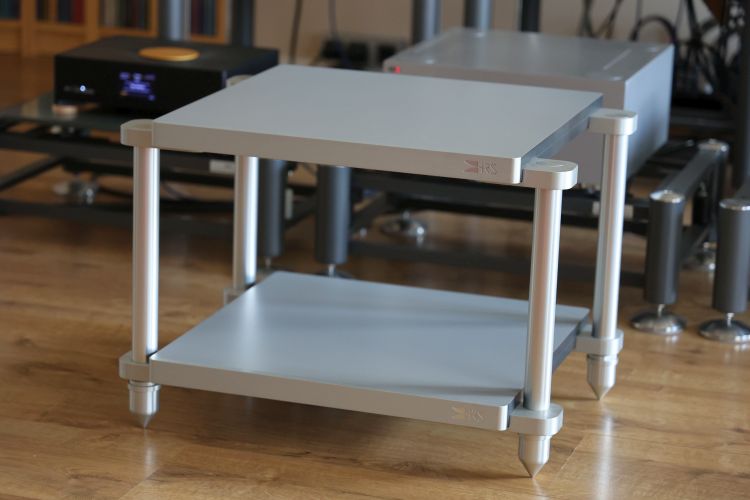
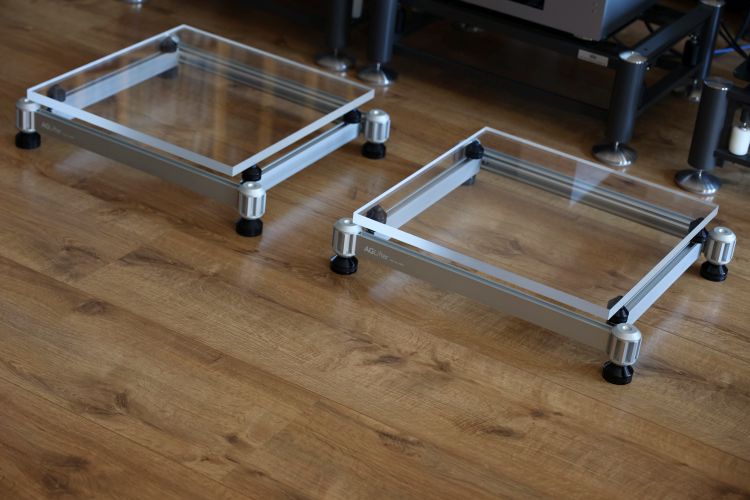
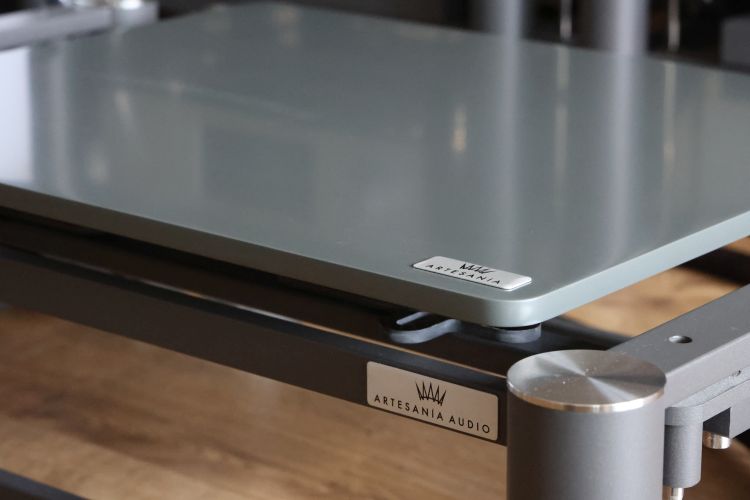
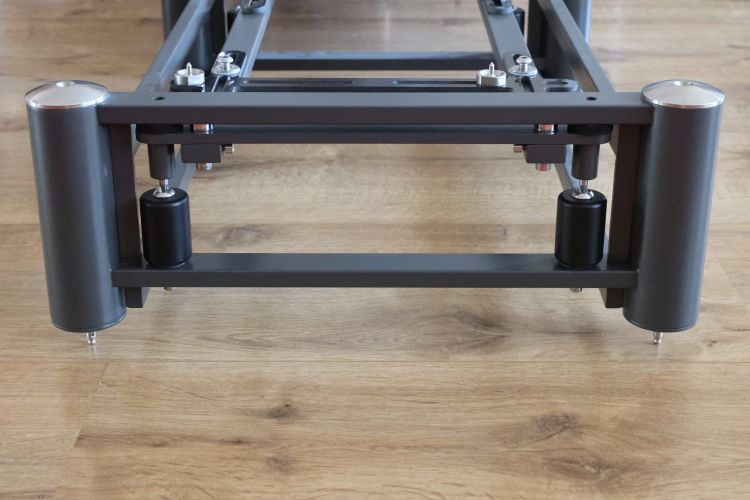
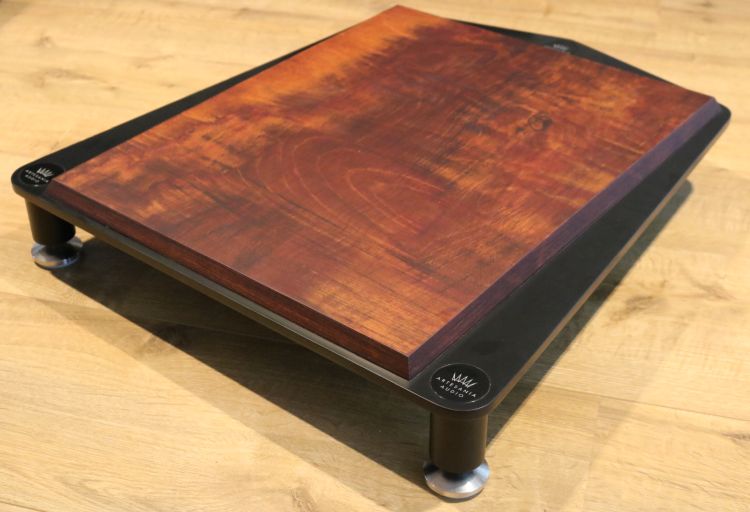
Hi Christiaan,
In your experience, do Artesania racks and amplifier stands settle down over a period of time, similar to how cables and equipment might undergo a burn-in process? And have you ever tried swapping between the white nylon floor discs and the black neoprene (or the newer beechwood) to “tune” the sound in a particular direction? Perhaps just two at a time to mix and match, instead of all four?
Hi Anton, While I did not find that the racks themselves need setting time, the 4 footers/dampers per level do. And ever since the manufacturer changed the pin thickness and supplied thicker PVC inserts for the footers, they also require special care in making sure that the spike heads are actually in touch with the metal top sides of the footers. Unless the equipment is very heavy, it can happen that the footers remain floating and that will cause a sound that lacks punch and drive. What I always do is remove the PVC inserts and cut them in half length-wise. Then, I reinsert them such that they are flush with the underside of the footer, so not inserted all the way. Then, I rotate each footer on, while making sure that metal to metal contact is established, and remains. There should be no springy motion.
As regards the main footer inserts, I found that Neoprene makes for a nice smoothness but also a softness in the bass and less incisive impact as I like. The Nylon inserts are my favorites, they provide a very transparent and airy sound. They do lack a modest amount of body and substance, but that is ok in my system. Depending on the version you get, you can also use the Beechwood inserts which are very nicely upbeat and musically pleasing but do deviate from neutrality in my opinion. Finally, you can also use the Stainless Steel floor discs without inserts. In some systems this brings a welcome extra robustness, body, and drive. It does come at the expense fo some fluidity, refinement, and air. I found that mixing or combining these inserts leads to diluted results so I would stick with one solution. But you can of course apply different footers for two different racks.
You can also adjust the rack’s tightness/flow with the screws in the base to limit or even lock the inner rack’s pendulum motion. I found that I prefer it with none of the screws touching the inner rack structure.
Finally, it is important to get the rack absolutely level with equal support on all 4 main footers. Then, it is imperative to adjust the inner rack such that there is no play. I do this by lifting it on one side and lowering again whilst taking note if one of the two spikes lands sooner than the other and then adjust accordingly. Note that these spikes can loosen over time so do check it now and then. And then, of course, you need to make sure that the component level footers are also allowed equally forceful connection to the component’s bottom.